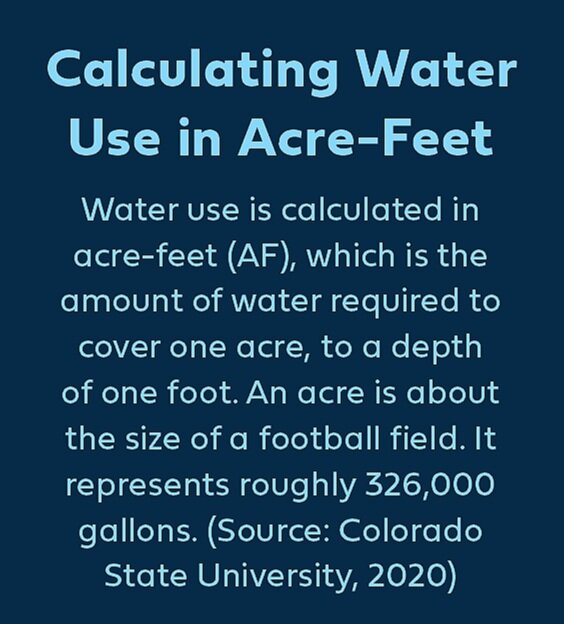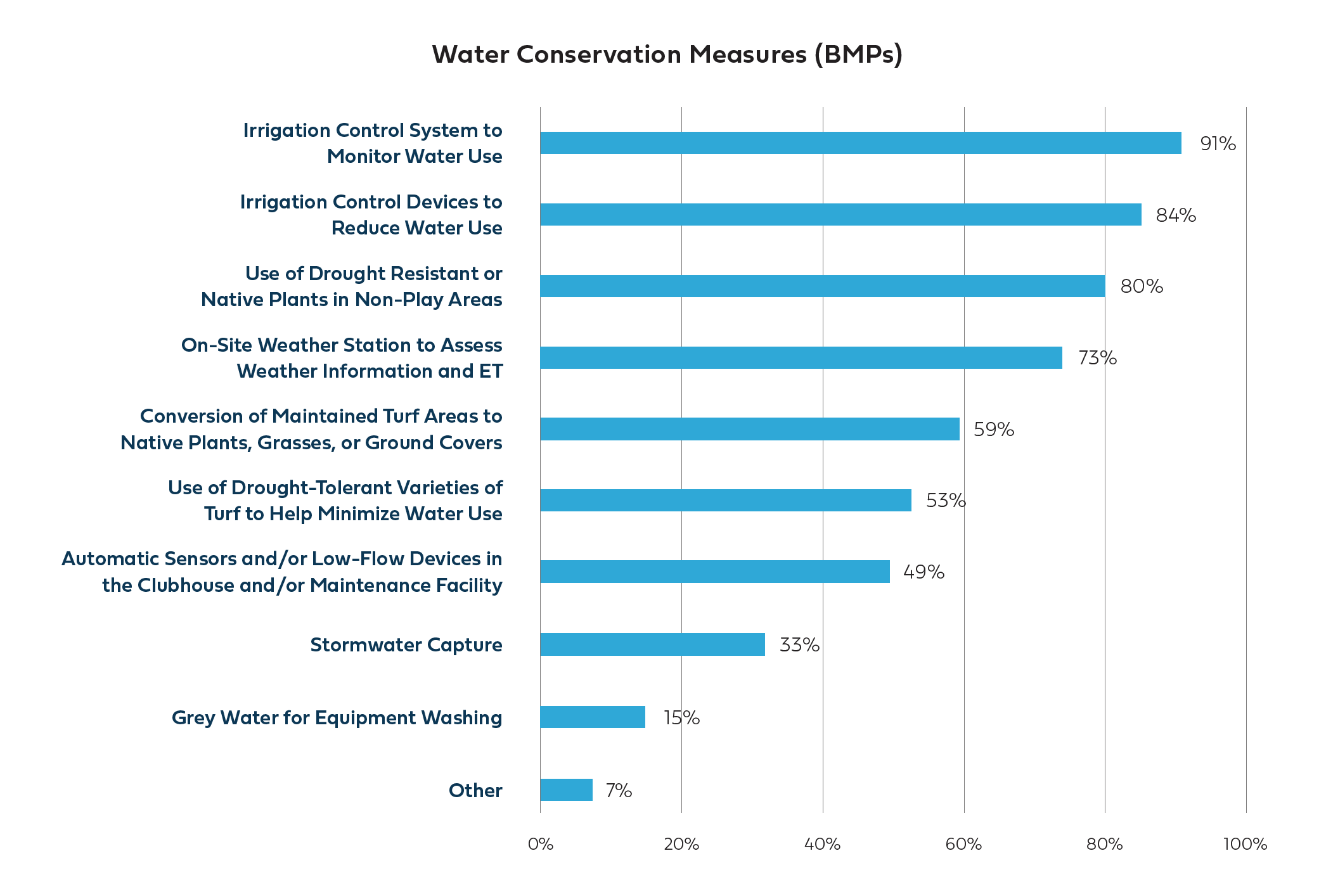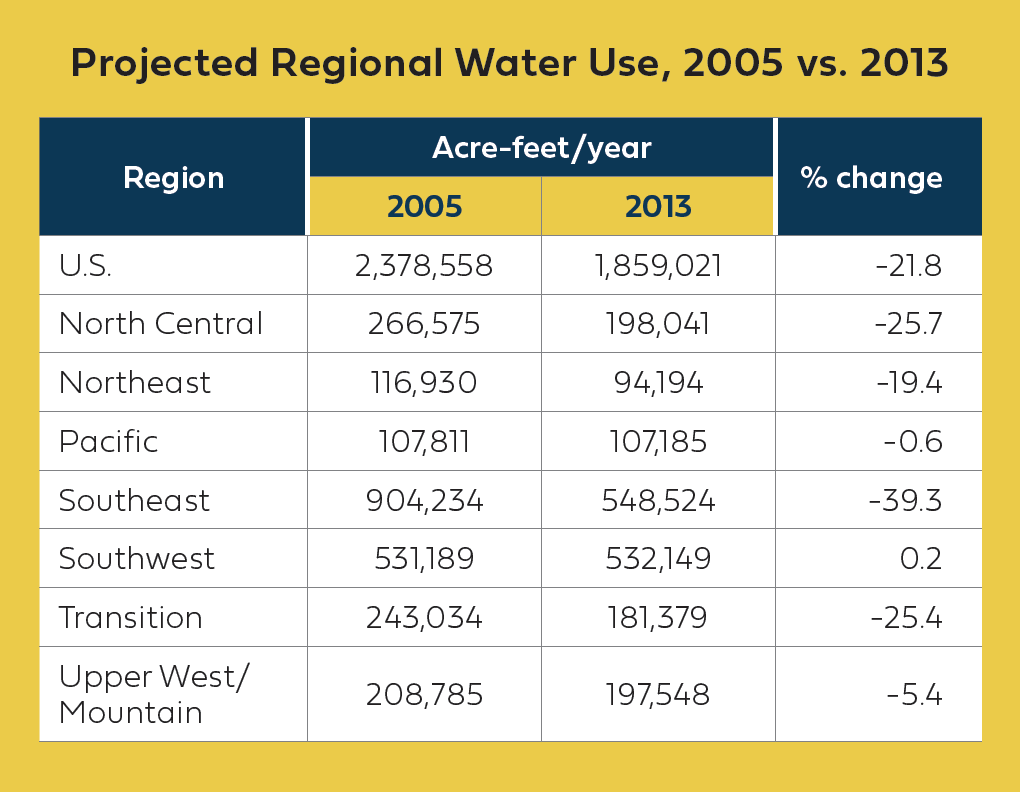Irrigation and Water Conservation
Water is a crucial natural resource for the state. The total amount of water that originates within Colorado averages 13.7 million AF per year. More than 60 percent of this water exits the state to downstream users. Less than 40 percent, or 5.3 million AF, is consumed on average per year in Colorado. Agriculture diverts 34 percent of the total amount of water originating within Colorado, which represents 89 percent of the total amount of water consumed. The Colorado Water Conservation Board (CWCB) estimates agricultural consumptive use to be approximately 4.7 million AF of water on an average annual basis. [8] In comparison, Colorado golf courses used 41,213 AF in 2018, representing less than one percent of the state’s annual water consumption.
Colorado has one of the fastest-growing state economies nationwide. Growth will increase water demands making it increasingly critical to implement conservation strategies. Colorado industries include beer brewing, snowmaking, energy and mining extraction, power generation, food processing, and others. In every industry, demand management strategies such as water conservation, water reuse, and land use play a crucial role in reducing municipal water demands.2 The Colorado golf industry has proactively approached demand management through development and education on its Colorado Golf Industry BMP Guide.
Colorado’s Water Plan incorporates values closely aligned with Colorado golf industry BMPs for sustainable water use. Education, outreach, and innovation are important success factors for each. Continuous education through the RMGCSA is provided with golf courses staying at the forefront of innovation. Implementation of efficient irrigation infrastructure, monitoring, and tracking systems helps promote healthy watersheds and protects water quality.
Colorado Golf Courses Water Use & Conservation
Of those surveyed, 96.6 percent have at least three or more water conservation practices in place with 71.6 percent having five or more; including irrigation control systems for monitoring water use, irrigation devices to lower water use, and drought resistant or native plants in non-play areas. These demand management practices contribute to reduced water consumption, healthy recreation, fitness, and tourism for the state.
More than one third of golf course acreage (35.8%) is native, or unmaintained, land that provides wildlife habitat and conserves water.
Maintained acres in 2018 totaled 21,206 vs 24,455 in 2002; representing a reduction of 13.3%.
Colorado golf courses encompass 33,061 total acres, but only 16,366 acres are irrigated turfgrass.
Colorado golf courses used 40,577 AF of irrigation water in 2018, representing 98% of total golf course water usage. This compares to 39,703 AF in 2002 as reported in the CGC report and 56,296 AF reported in the USGS report covering 2005.
Irrigated acres were 16,366 compared to 19,800 in 2002 with an AF per irrigated acre rate of 2.479 compared to 2.27 in the USGS 2005 data and 2.005 in 2002.
Irrigated water usage decreased 28% vs USGS data reported for 2005 and increased 2% vs 2002.* In comparison, total water use was reported in 2002 however irrigated water use was not explicitly specified. Using 2002 reported ‘watered acres’ and a coefficient for irrigated water use per square foot, irrigated water use would be slightly up in 2018 vs 2002 however using irrigated water as a percent of total water used1, irrigated water use in 2018 is lower by 13.4% (40.6K AF in 2018 vs 46.9K AF in 2002) following a similar trend to the overall water reduction of 13.9%. In this case, total water use is a better indicator of water use trends for Colorado golf courses.
Total water usage for Colorado golf courses in 2018 was 41,213 AF of which 54.2% was surface water, 27.3% was reclaimed wastewater, 14.2% was ground water/well self-supplied, 2.8% other, and 1.4% came from municipal sources.
In 2002, 88% of water used on golf courses was non-potable, including 52% surface water, 20% reclaimed wastewater, and 16% well water. 12% of water used came from municipal water sources.
32% of Colorado golf courses used reclaimed water in 2018 which is above the national average of 15.3% and also above the regional Upper West/Mountain average of 18.1% as measured by the GCSAA in 2013.
Denver Metro Region has a large portion of reclaimed water use at 39.3% which is notably higher than the rest of the state.
Water use and sources may vary due to differences in temperature, geography, water accessibility, and maintenance operations; factors may include precipitation, soil types, temperature, irrigation and xeriscape practices, turfgrass species, etc.
Irrigation audits for golf course irrigation systems were performed by 51.1% of survey respondents, and 69.9% of survey respondents who confirmed conducting irrigation audits made adjustments to their irrigation systems after the audit was conducted, for an average irrigation water savings of 12.5 AF of water per facility per year.4
USGS Water Use Data for Colorado
In 2005, according to the USGS’ Estimated Colorado Golf Course Irrigation Water Use, published in 2009, Colorado had 243 turf golf courses with approximately 24,800 acres of irrigated turf. [13] The USGS estimated 2.27 AF per irrigated course acre and 66 percent of the source water for Colorado golf courses was from surface water.
Ground water provided 15%, reclaimed wastewater provided 11%, and potable public supply provided 8% of Colorado golf course irrigation water in 2005 based on USGS data.
Irrigation (combined crop and golf course) totaled 12,362.49 Mgal/d or 91% of the total water withdrawals in the state of Colorado for 2005.
Crop irrigation accounted for 99.7% (12,321.85 Mgal/d) of irrigation in 2005, whereas the 243 golf courses in Colorado accounted for 0.3% (40.64 Mgal/d) of total irrigation water withdrawals.
GCSAA National & Regional Water Use Data
In 2009, GCSAA published the Golf Course Environmental Profile Volume II Water Use and Conservation Practices on U.S. Golf Courses and in 2014, GCSAA published the Golf Course Environmental Profile Phase II Volume I 2014 Water Use and Conservation Practices on U.S. Golf Courses. [14, 15] It reported the following:
Approximately 80% of maintained turfgrass or 80 acres of an average 18-hole golf course’s 100 acres of maintained turfgrass are irrigated.
At the individual level, an average 18-hole golf facility covers 150 acres, approximately 100 (67%) of which is maintained turfgrass.
Nationally, nearly 100% of greens, tees, and fairways are irrigated. Approximately 64% of turfgrass in the rough and 74% of turfgrass used for the driving range/practice areas are irrigated.
Water use per 18-hole golf course (in median AF) for the Upper West/Mountain Region in 2013 declined by 9.6% vs. 2005. Total projected annual AF for the Region declined by 5.4%.
[8, 9] Colorado’s Water Plan. (2015) Retrieved from https://www.colorado.gov/pacific/sites/default/files/CWP2016.pdf
[10] Golf Course Superintendents Association of America Golf Course Environmental Profile Volume II Water Use and Conservation Practices on U.S. Golf Courses. 2009. Retrieved from https://www.gcsaa.org/uploadedfiles/Environment/ Environmental-Profile/Water/Golf-Course-Environmental- Profile--Water-Use-and-Conservation-Report.pdf
[11] Golf Course Superintendents Association of America Golf Course Environmental Profile Phase II Volume I 2014 Water Use and Conservation Practices on U.S. Golf Courses, 2014
[12] Irrigation audit participation data (n=54), adjustments to irrigation systems (n=27), and average water savings (n=19) comes from the 2020 Colorado golf facility economic impact survey conducted by NGF. National Golf Foundation. (2020). Proprietary Research. 2020. Colorado EIS. N=54, 27, 19 respectively.
[13] US Geological Survey, Estimated Colorado Golf Course Irrigation Water Use. (2005). Retrieved from https://pubs.usgs.gov/of/2008/1267/
[14] Golf Course Superintendents Association of America Golf Course Environmental Profile Volume II Water Use and Conservation Practices on U.S. Golf Courses. (2009). Retrieved from https://www.gcsaa.org/uploadedfiles/Environment/Environmental-Profile/Water/Golf-Course- Environmental-Profile--Water-Use-and-Conservation-Report.pdf
[15] Golf Course Superintendents Association of America Golf Course Environmental Profile Phase II Volume I 2014 Water Use and Conservation Practices on U.S. Golf Courses. (2014). Retrieved from https://www.gcsaa.org/docs/default-source/Environment/phase-2-water-use-survey-full-report.pdf?sfvrsn=2b39123e_4

















